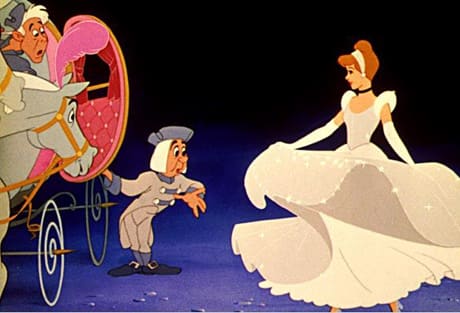History could define three specific phases of Disney animation: the pre-war Golden Age of Animation (1937 to 1942), which included Snow White, Pinocchio, Fantasia, Dumbo and Bambi; the post-WWII films, from Cinderella (1950) to The Aristocats (1970); the post-Walt period of films conceived after his death, from Robin Hood (1973) to Oliver and Company (1988); and, finally, the studio resurgence under the Jeffrey Katzenberg regime ― the pre-Pixar period, from The Little Mermaid (1989) to The Lion King (1994). The Golden Age of Animation is still the height of Disney's artistic endeavours, a monumental creative output that put the "magic" in "the Magic Kingdom." Arguably there were lesser returns post-WWII; it took eight years after Bambi for Walt Disney to produce his next full-fledged animated feature, Cinderella, a return to the bread and butter subject matter. It's the well known fairy-tale of a downtrodden step child of an abusive mother who, with the help of the magical creatures of the land and a fairy godmother, usurp the destinies of her evil step-sisters to capture the heart of the handsome prince. While the spark of the Golden Age was lost somewhere in those intervening eight years, Cinderella still resonates as a marvellous example of classical Disney animation, a style and tone absolutely non-existent in today's animated films. There's purity to its subject matter that's devoid of any self-acknowledgement, and no post-modern cinematic or pop culture references whatsoever. Uncle Walt always preferred the collaborative method of animation, assigning sequences to different animators, the effect of which made each film feel like a series of sequenced set pieces. In Cinderella, this feeling remains. Of the memorable standalone scenes there's the action-oriented interactions of Lucifer the evil cat and the helpful mice; the dressmaking sequence, where the magical animals of the kingdom work together to craft the dress for Cinderella to wear to the ball; and, of course, the fairy godmother's transformation of Cinderella in preparation for the ball, including the memorable "Bibbidi-Bobbidi-Boo" song. Cinderella features some of the most striking visual compositions of any of the Disney features; it's the most baroque of the Disney films up until then. The stepmother's castle is wonderfully Roman-esque ― inspired by the Neuschwanstein castle of Bavaria, it became the most iconic of the Disney brand imagery. Disney uses this elegant, but imposing extravagance throughout the film ― look for the expressive use of long shadows and other haunting noir and gothic imagery to create the film's unique, brooding, Germanic feeling. The special features of the Disney Diamond Collection include an alternative opening scene, a look back at the real life inspiration for the memorable fairy godmother character, a more comprehensive making-of featurette and a short film based on new CGI animated feature Tangled. It's a curious addition that shows the dramatic difference of animation styles between 1950 and today.
(Disney)Cinderella
Clyde Geronimo, Wilfred Jackson, Hamilton Luske

BY Alan BacchusPublished Oct 12, 2012